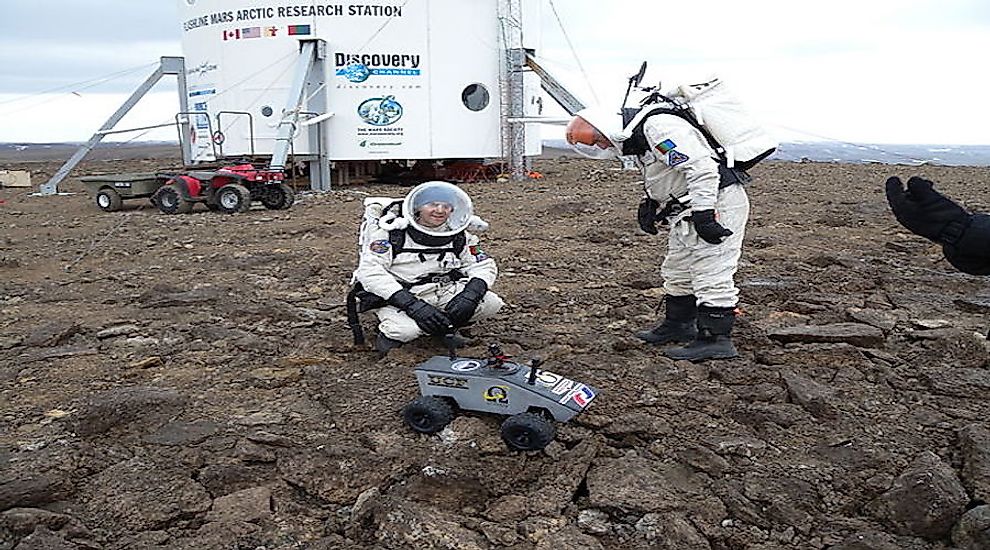The Largest Uninhabited Island in the World

Where Is Devon Island Located?
Devon Island, the world’s largest uninhabited island, is located in the Baffin Bay in Nunavut's Qikiqtaaluk Region in northern Canada. It is the 27th largest island in the world. Ellesmere Island lies to the north of Devon Island and Baffin Bay lies to its east.
History Of The Devon Island
The island was discovered by William Baffin and Robert Bylot in 1616. It was initially named North Devon after Devon in England by W.E. Parry. In the 1800s, it was renamed as Devon Island.
In 1924, a small outpost was established at the Dundas Harbor on the island and, 9 years later, it was leased to the Hudson's Bay Company. When the fur trade collapsed, 53 Baffin Island Inuit families arrived on Devon Island in 1934 in the hope of building their homes here. All attempts were unsuccessful and the harsh conditions of the island forced them to flee in 1936. In the 1940s, fresh attempts to live here were made but discarded again in the 1950s. Since then, no permanent settlements have grown up on Devon Island, and the ruins of only a few buildings remain here.
The Geography Of The Devon Island
The Devon Island is about 320 miles in length and 80 to 100 miles in width. The area occupied by the island is 21,331 square miles. The island is at an elevation of about 2,000 feet in the west and gradually rises to 6,300 feet in the east. At 6,300 ft, the Devon Ice Cap is the highest point on the island. Several small mountain ranges are also present here. The southern coast of the island has several fjordlike inlets and the Grinnell Peninsula protrudes from the northwest of the island. The eastern third of the Devon Island remains permanently covered with an ice cap about 500 to 700 meters thick. The mean annual average temperature of the island is -16°C.
Life On The Devon Island
Although completely devoid of human settlements, a few species reside on the island. The short growing season of only about 40 to 55 days and the low temperatures (2° to 8°C in summer) discourage the growth of plants here. Winters are extremely harsh with temperatures being as low as −50 °C. Invertebrates living on the island take 2 to 9 years to complete their life-cycle when similar animals in other more habitable places complete their life-cycle within a few weeks to a year. The limited solar energy input is also one of the factors influencing the existence of life on this island. Little precipitation is also received on the Devon Island.
A small population of musk oxen and small mammals and birds live here. The island also supports hypolith communities. The Truelove Lowland area is a more biodiverse area since it supports a relatively lush Arctic vegetation. Cape Liddon on Devon Island is regarded as an Important Bird Area (IBA) with a notable population of northern fulmar and black guillemot.
"About As Mars As It Gets"
Devon Island is home to a 14-mile wide Haughton Crater. The “out-of-the-world-like” landscape here is cold, dry, and rocky. Its location in isolation from the rest of the world and continues to exist as if located on another planet. Thus, no humans dare settle on this land although astronauts preparing for Mars missions do pay occasional visits to Devon Island to get used to extra-terrestrial conditions.
Researchers have tested robots, spacesuits, drills, and other objects on Devon Island that would help prepare for future missions to Mars. The unmapped land and brutal environment of the Devon Island allows the space crew to get a taste of what is would be like to land in a place where nothing is predictable.
In 1960, the Devon Island Research Station was established in the Truelove Lowland and is maintained by the Arctic Institute of North America. The island also served as the temporary home of 5 scientists and 2 journalists in July 2004. They were there to get used to the Mars-like environment on the island to simulate working on Mars. The Haughton crater on Devon Island is the site of NASA's Haughton Mars Project.











